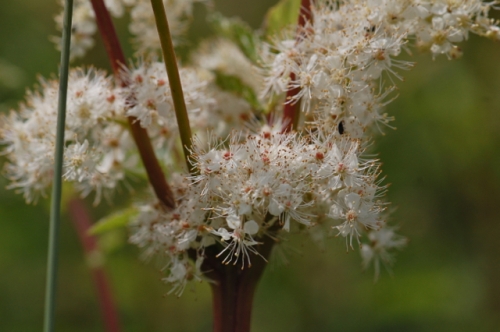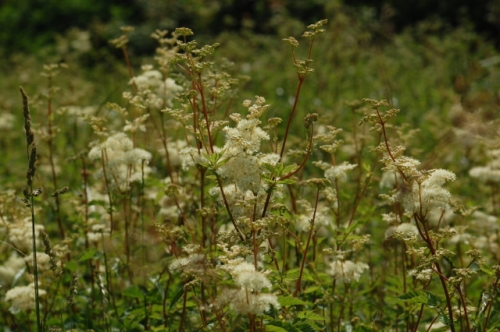Last week I had the pleasure of harvesting meadowsweet on one of the few sunny days so far this summer so I thought it would be an opportune moment to share some information and thoughts on this most useful of herbs.
Common name: Meadowsweet. Also Queen of the Meadow, Brideswort, Meadwort.
Latin: Filipendula ulmaria.
Family: Rosaceae – Rose family.
Botanical features: A perennial herb that enjoys damp conditions and grows abundantly throughout most of the UK in meadows, ditches, road or stream-sides. It has reddish brown stems growing up to 1.5 metres high and deep green pinnate leaves that are paler on the underside. It bears creamy puffs of tiny, fragrant flowers that bloom between May and August, though I personally have never seen them before mid June.
Key Constituents: Volatile oils, methylsalicylate, tannins, mucilage, flavonoids, phenolic glycosides.
Actions: Anti-inflammatory, anti-rheumatic, antacid, stomachic, astringent, diuretic, diaphoretic, carminative, anti-emetic.
Energetics: Cooling and drying.
The name meadowsweet is said to come, not from the fact that it grows in meadows as one would expect, but from its early use to flavour mead, evolving from Middle English Medewurte, as it appears in Chaucer’s The Knight’s Tale.
This is a herb that has had its place through all the ages of European history. Evidence of meadowsweet has been found in several Bronze Age burial sites suggesting the value placed on it even many centuries BCE. The Druids are said to have considered it one of their most sacred herbs for use in ritual and medicine and it was a favourite of medieval herbalists too, being regularly used by folk healers and monastic communities alike. It was prized at this time as a strewing herb, one that was used to cover floors in medieval homes and churches to disguise unpleasant smells, reduce fleas and lice and help counter infections.
In Irish mythology, Cú Chulainn, the warlike hero of the Ulster Cycle, is said to have used meadowsweet baths to calm his rages and fevers and in Wales, the beauteous but adulterous Blodeuwedd, was made by two magicians from the flowers of oak, broom and meadowsweet.
It is perhaps most famous for its role in the development of aspirin however, a drug named after its previous Latin name, Spiraea ulmaria. In the mid nineteenth century salicylic acid was isolated from meadowsweet which lead to the later creation of aspirin.
Within the herbal world meadowsweet is very much considered a specific for the digestive system but it had many other uses in traditional medicine that have now mostly fallen by the wayside. Just like Cú Chulainn, people commonly used it as a treatment for fevers where it works through a gentle diaphoresis as well through the effects of salicylic acid in reducing inflammation and heat. It was used to treat hot conditions in other ways too; cooling sunburn, as a wash for inflamed eyes, as a compress for swollen, arthritic joints, to give relief from headaches and for calming an irritated cough. It is interesting that even before the discovery of salicylic acid many people used meadowsweet for conditions that they may take aspirin for today.
The smell is very distinctive and I have heard it compared to everything from deep heat to marzipan to pickled cucumber! To me it smells sweetly fragrant with an edge of the disinfectant TCP that I remember from childhood. Interestingly I recently found out that TCP contains salicylates so perhaps there is method in my madness after all!
In fact, meadowsweet is sometimes referred to as ‘herbal aspirin,’ a name which I find both inaccurate and vaguely insulting to this multi-talented meadow queen! It is noted, at least in the herbal community, that meadowsweet is a fine example of how nature so often buffers chemicals that can do damage with others that soothe and heal. So where as aspirin can increase the chances of indigestion, GI bleeds and ulcers, meadowsweet can be used to heal these exact same conditions.
Despite its cooling and drying nature, meadowsweet can be considered a normaliser for the digestion in the majority of people as it can help to balance both high and low stomach acid. This is interesting as it is increasingly acknowledged that symptoms of heartburn and indigestion can be caused by both hyper and hypo acidity in the stomach. As an astringent it helps to tone the stomach and the mucus membranes and it also increases their rate of cell renewal allowing irritated areas to heal quicker.
Due to its volatile oil content it has a carminative action and it also has some bitterness which can help stimulate digestion, increase bile flow and therefore relieve congestion in the liver. The astringency is balanced somewhat by this ability to stimulate and move so that it can still be effective for those with under active digestions. One herbal friend of mine uses it for everyone with gut problems and just moderates the actions with other herbs specific for the individual.
This effect on the mucus membranes can also be seen in the urinary system where it has been employed to treat cystitis through it’s healing, anti-inflammatory and anti-bacterial properties. It is also considered mildly immunomodulating and a useful diuretic.
You can use it as a tea, preferably taken hot for fevers to help stimulate the diaphoretic action and slightly cooler for digestive discomforts. It is gentle enough for use with children in whom it has been found effective in treating diarrhoea. Tincture is the way I most commonly use it and it is particularly nice made from fresh flowers in 25% alcohol.
A compress made from a flannel soaked in hot meadowsweet tea is an old fashioned remedy for arthritis and gout.
The general wisdom is to avoid this herb with people who are sensitive to salicylates or if they are taking warfarin as there is the potential of an additive effect.
“How lovely she is, queen of the springs and of the running brooks, standing there in the damp shady places with her big clouds of flowers; little white flowers that make up big feathery tufts and give off a strong sweet perfume.”
Maurice Messegue







